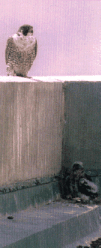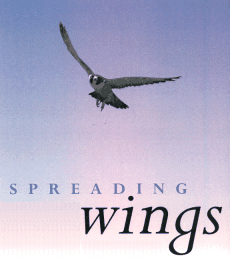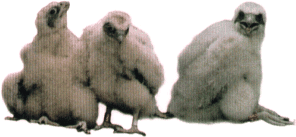


High on the east ledge of the Clinical Sciences Building, all is quiet. After weeks of activity around the nest site of two peregrine falcons, it appears to be abandoned. But try going up to look inside and you may be risking your life.

|
According to Alberta Environmental Protection biologist Gordon Court, inactivity this time of year means the female is inside sitting on her eggs, with the male perched somewhere in the distance guarding. Mess with mama, nicknamed "the Flying Scalpel," and you'll likely be given a violent warning.
"I've seen them in the arctic drive off large carnivores (like grizzly bears)," says Court, who monitors peregrines to track their movements and population levels. "The female there now is extremely aggressive. Certainly anyone on the ledge of the Clinical Sciences Building would not be very welcome."
Neither are other birds. One unlucky female peregrine tried moving in on the Flying Scalpel a few weeks ago and almost lost her head. Dr. Steve Hrudey in environmental health sciences witnessed the whole drama from his office window.

|
"There was a tiff going on this spring. For a few days there were three adults swooping around. One of them was sitting on top of the house, and it must have been the aggressive one who came dive-bombing in there and just knocked the other one right off. I thought she had taken her head off... it's pretty vicious."
Hrudey says visiting television crews have also riled her. "Those guys are a little naive about this... one guy got scraped up, had blood coming down his head, the whole nine yards." Court always wears a motorcycle helmet and leather jacket when working around peregrines.
Competition over three nest sites in the city -- the U of A, one on the Telus building downtown and another at Inland Cement in the west end -- is also a good sign the species is making a comeback.
Courtesy of Alberta Environmental Protection |
Once all but gone from Alberta, the peregrine population is now on the rise, largely because of the banning of DDT in Canada in 1969. Until very recently, however, the falcon was still threatened by the pesticide when it migrated to countries in Central and South America. Now that DDT is no longer commonly used there, says Court, residue in falcon eggs has been steadily dropping, and the peregrine's future looks bright.
Court says the two adults now living on campus are likely the descendents of some 34 captive chicks released in the '70s and early '80s from the Longman building on the university farm. For some inexplicable reason, even back then, some of the fledglings took their maiden flights straight to the Clinical Sciences Building.
Hrudey noticed the first in 1991, and while the current 11-year-old male is closing in on the average 14-year life span for an urban peregrine, the nest will probably always be in use, says Court.
"Once it's established as a chosen spot, you'd have to tear the building down to make it unattractive." There must be something about the building, he says, that looks good from the air. Perhaps the ledge resembles a cliff. Perhaps the falcons somehow sense their chances of survival there are strong.
What Court does know is that it's a great place to learn how to fly. There are no great horned owls around (their main predator) and when they do happen to fall, there are enough people walking by to come to their rescue.
"It's pretty amazing -- at about 40 days of age most of them do pretty well flying. But it's like giving a 12-year-old kid one of those Kawasaki Ninja motorbikes -- they have all the equipment to go 250 miles an hour, but no knowledge of how to use it." Court says if the chicks fly off the building in a good wind, they can hit speeds of 100 miles per hour. Unfortunately, they often collide with something. Roughly half of them perish in their first year.
If all goes well, this new clutch of chicks will hatch by mid-June, when Court will once again don protective gear to place bands on them. By the end of July, the fledglings will take to the air.
![[Folio]](http://www.ualberta.ca/~publicas/folio/gif/small/folio.gif)
Folio front page |
![[Office of Public Affairs]](http://www.ualberta.ca/~publicas/gif/small/opahome.gif)
Office of Public Affairs |
![[University of Alberta]](http://www.ualberta.ca/~publicas/gif/small/uahome.gif)
University of Alberta |